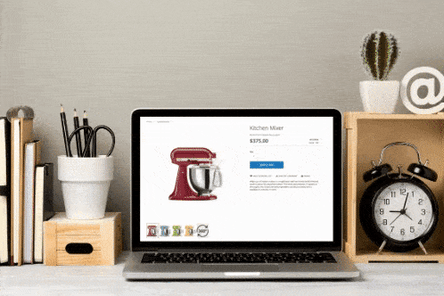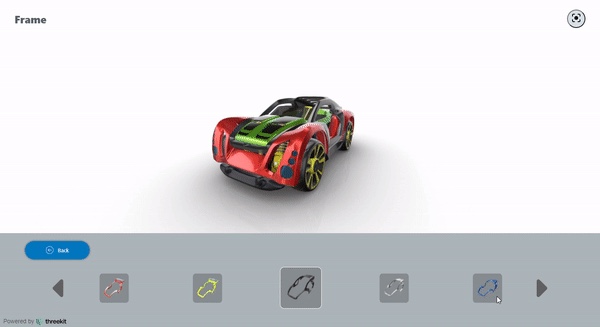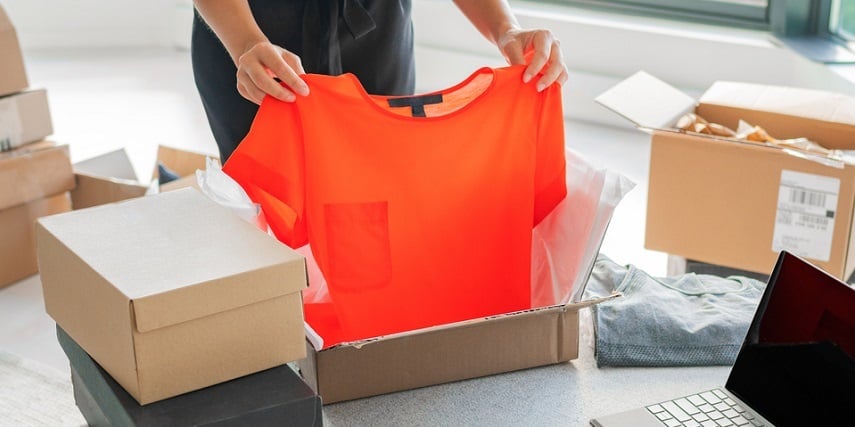6 Ways Better Product Imagery Can Help Improve Your CX
As any eComm marketer knows, better customer satisfaction has long been correlated with higher revenue and greater profitability, and these are numbers you have the power to impact. When your customers can’t come into your brick and mortar store to shop, improvements to your online customer experience take on a new sense of urgency.

The key to unlocking the eCommerce puzzle that many marketers may be missing is a concrete way to improve nearly every aspect of the user experience: use better product imagery on your eCommerce website.
While five to eight images of every product is a good baseline for product photography, static product photos don’t provide the same, comprehensive view as a 360 product visual, whether that’s through a 3D product rendering or virtual photography.
Here, we’ll break down six ways in which higher-quality imagery—whether you incorporate a 360 product view for every item in your catalogue or an augmented reality (AR) product experience—can improve the customer experience for your target audience and build long-lasting customer loyalty.
1: Build trust using 3D product photography and 360 product viewers
Research shows that high-quality images help build trust among online shoppers. This means that at the very start of the customer journey, the quality of your visual content can make or break the experience.
But today’s online shoppers expect more than the bare minimum of product information.
Let’s look at how one of the most popular household brands of the pandemic is bolstered by a mixture of 3D product photography and images that place the product in context:
Sure, King Arthur Baking ’s three-pound bag of unbleached all-purpose flour was on sale when this was being written, but that’s not why it caught our eye:
- Their marketers wisely included 3D product photography to present the front and back of the bag. This ensures that shoppers can clearly read all product labels.
- The photo of the bag sitting on the counter helps confirm the shopper’s sense of the product’s relative size and that the bag is made of plastic. Perhaps more importantly, shoppers can easily see that the bag has been cut open and that it is indeed resealable for easy storage.
- The images of the appetizing slices of toast remind shoppers why they’re browsing the internet for dry goods in the first place.
But really, why does it matter what this bag of flour looks like?
This variety of product images confirms the shopper’s understanding of what’s on offer and accurately sets their expectations for the specific product they’ll receive in a box on their doorstep next week. These product visuals help build the shopper’s trust, confidence, and enthusiasm for the purchase they’re about to make, all of which contributes to a better customer experience.
2: A 360 product view can save your customers time.
The human brain can process information from an image in just 13 milliseconds—but it takes us up to six seconds to read 20 to 25 words. Images communicate information faster than text, and a 360 product visual communicates far more than six static images.
But in addition to providing the right kind of visual information, you need to make sure you’re delivering a visual experience at the right speed. Successful eCommerce retailers know what they need to do to convert customers, and this means providing an excellent customer experience on mobile.
A recent study by PYMNTS found that 53.3% of all consumers used their mobile devices to help them complete their most recent purchases. For over half of the market, the baseline for a great customer experience today is built on a speedy mobile experience.
Saving your customers time by showing them the right visual information is only part of the puzzle. To ensure that your 360 product visuals improve your CX, your product page must have the digital infrastructure to quickly load a 360 product view.
3: Solve customer problems with an online product configurator and AR capabilities.
A great customer experience helps relieve uncertainty: the right product images can help do this by showing shoppers the exact product they are considering purchasing from every angle. Product visuals can make a difference when it’s time for shoppers to choose between moving forward with a purchase or abandoning their cart.
If you’re selling a product with many possible configurations like a sofa with 16 possible fabrics, or a build-it-yourself engagement ring, you can use pre-rendered images generated with virtual photography or real-time interactive 3D to proactively answer shoppers’ questions about exactly what their configuration will look like, from fabric to finishes.
CB2’s furniture shopping experience is one of our favorite examples of this technology, because their built-in online product configurator allows shoppers to preview the piece exactly as they’d like to order it and then use their AR tool to preview the furniture in context.
The excellent customer experience this delivers—getting to see how your new custom couch will look in their own space—is no longer exceptional. In fact, an AR experience is already available to customers through 41% of retailers today, and nearly half of retailers say they’ll offer AR in the future.
As AR becomes the new standard for an excellent customer experience in digital retail, it will become increasingly important to have 3D renderings of your product catalogue to share.
To see how you can brush up your eCommerce experience to be more like CB2’s, schedule a demo.
4: Leverage a 360 product visual to make online shopping engaging and enjoyable.
Plenty of consumers enjoy online shopping for the thrill of finding a great deal, but many others enjoy dreaming of a custom car or living room design. For others, it’s all about customizing their gear. And brands that successfully use online product configuration to deliver this kind of engaging customer experience see the benefits.
This is why Nike doesn’t just provide flat images that show you the sneakers you’re about to purchase from every angle, although they do provide beautiful product images. They also let shoppers use the online product configurator to build a 3D visualization of the shoes a shopper is about to buy:
This process generates a 3D product image, which helps demonstrate that your customers can count on your brand to deliver the exact product they’re looking for.
As any sneakerhead will tell you, every detail matters when it comes to their custom Nikes. Precise, 3D product configurations help turn shoppers into customers who genuinely enjoy playing with the design of their kicks and who want to come back to your site to design their next pair.
5: Reduce unpleasant surprises with the help of an online product configurator.
A full 22% of product returns happen because the product a customer received didn’t match the one they ordered.
eCommerce brands can reduce the likelihood that a customer will have an unpleasant surprise when their package arrives in the mail by providing product imagery that shows exactly what the customer can expect.
For significant, emotional purchases like custom engagement rings, there’s a reason online jewelers provide more than a CAD file. A 3D rendering of the item can help shoppers triple-check that their order will meet their expectations, from the cut of the diamond to the spelling of any custom engraving.
A visual product configuration can help you provide an even higher-touch customer experience than what brick and mortar retailers can provide in-store. Give shoppers the ability to preview the 3D configuration of the engagement ring of their dreams.
Schedule a demo to find out how your products might look through an online product configurator for today.
6: Reduce the frustration of returns by providing a 360 product view before checkout.
The best way to reduce the number of returns your customers make is to deliver the right product the first time around. The good news is that excellent product imagery has been shown to make a difference: rotating 360 product visuals can reduce returns by as much as 50%.
While try-on AR isn’t ready for broad quite yet quite, configurable AR is a fun tool for shoppers who want to preview their purchase in their space: in the furniture industry, everyone from CB2 to IKEA is headed in this direction.
While AR for eComm is still evolving, one pioneering online retailer has been doing try-on AR well for years. Warby Parker has been successfully selling glasses frames online by blending their digital, at home, and in-store experience. But as their website’s current landing page attests, today it’s all in the app:
Warby Parker provides configurable product images for all of their glasses frames online and an exceptional AR experience in their app. This combination allows customers to curate a box of frames they’d like to have shipped to them in their homes to try on in real life or to virtually try on frames using a configurable 3D product rendering from the comfort of, well, wherever they are.
In the world of infinite scrolling, a memorable and engaging customer experience with AR can make a difference.
3D product imagery makes for a better customer experience.
Remember when we all used to walk into a store, pick up a pair of jeans, and walk them back to the dressing room to try on?
That experience can’t be replicated from home, but you can make shopping a fun and engaging experience by bringing today’s digital marketing tools, like our Virtual Photographer to your eCommerce web experience.
Visual content like high-quality eCommerce images, interactive 3D, 360-degree rotations, and AR can all help create the kinds of experiences that win customer trust and inspire them to return to a brand again and again.
Schedule a demo to find out how you can improve your customer experience with an online product configurator today.
Note: Content updated with additional data August 11, 2020
Threekit's product visualization software creates photorealistic images, interactive 3D and augmented reality experiences that help businesses sell more. To learn more, please schedule some time with one of our teammates.


